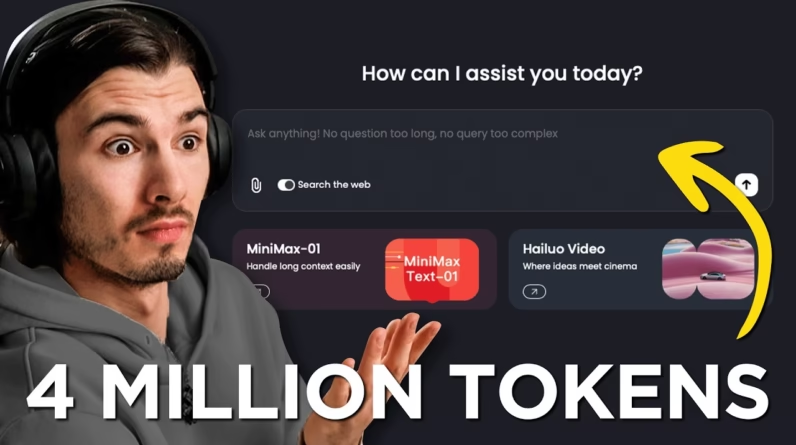
Building an AI business without coding skills is more achievable than ever, thanks to no-code development platforms. This article highlights a journey to create a profitable startup named “gogetjob” within just 72 hours. The focus is on tackling the challenges faced by job seekers, like customizing job applications and preparing for interviews.
You’ll learn about the steps taken from brainstorming and validating the startup idea to using various digital tools for branding and marketing. With a blend of automation and outreach strategies, discover how this entrepreneur not only launched the platform but also generated revenue right away, all while keeping costs minimal.

Table of Contents
Understanding No Code Development Platforms
Definition of No Code Platforms
No code development platforms are tools that allow individuals to create software applications without needing to write traditional programming code. These platforms use visual interfaces and drag-and-drop features that enable users to build complex applications by connecting pre-existing functionalities. If you’ve ever dreamed of bringing your ideas to life without having to learn a programming language, no code platforms are the perfect solution for you!
Advantages of No Code Development
The rise of no code development has several advantages. First, it drastically reduces the time and cost of building applications. You can quickly turn your concepts into functional products, making rapid prototyping a breeze. Second, these platforms are user-friendly, catering to those who may not have a technical background. This opens up the world of app development to anyone with a vision, empowering entrepreneurs and creatives alike. Lastly, no code platforms often come with built-in integrations for various services, allowing for seamless connections between your application and other tools you might use.
Target Audience for No Code Tools
The primary audience for no code tools includes aspiring entrepreneurs, small business owners, and those looking to solve specific problems without having extensive technical skills. Individuals in the startup ecosystem, such as marketers, designers, and product managers, can also benefit by quickly validating ideas and launching MVPs (Minimum Viable Products) without the need for a full development team. If you find yourself needing to develop a solution quickly, no code platforms give you the chance to dive right in.
Identifying Market Needs for AI Solutions
Assessing Job Market Challenges
With the job market constantly evolving, many job seekers face significant challenges, including fierce competition, rapidly changing industry demands, and often cumbersome application processes. You can take advantage of these challenges by developing an AI solution that targets specific pain points in the job application process.
Gathering Insights Through Networking
One of the most effective ways to identify market needs is to reach out to your network. Engage with friends, family, or professional contacts and ask about their experiences with job searching. You might discover common frustrations like poorly timed applications, tedious customization of resumes, or the struggle to prepare for interviews—all of which represent opportunities for you to create tailored solutions.
Defining User Pain Points
To truly understand user pain points, you need to empathize with their experiences. Whether it’s the overwhelming task of tailoring your resume for each position or the anxiety that comes with interview prep, pinpointing these issues can guide your development process. By addressing these challenges, you can create a solution that resonates with your target audience and provides real value.
Generating Profitable AI Business Ideas
Brainstorming Session for AI Solutions
Gathering a group of creative minds or even just reflecting on your own thoughts can lead to an effective brainstorming session. Write down all possible solutions to the problems identified—there’s no idea too wild! Keep an open mind and encourage even the most unconventional ideas. You never know which thought might spark the next best thing.
Evaluating Feasibility of Ideas
After collecting a range of ideas, it’s essential to evaluate the feasibility of each concept. Consider factors like market demand, competition, resource requirements, and the time it would take to build and launch your solution. This step ensures that the ideas align not only with your interests but also with market dynamics, setting you up for potential success.
Selecting the Most Viable Concept
Once you’ve assessed various ideas, focus on the one that demonstrates the most potential. It could be the concept that fills a significant gap in the market or the solution that harmonizes with your skills and passion. Choosing the right idea is crucial as it will ultimately steer your efforts moving forward.
Creating a Startup Concept: Resume Optimizer
Concept Development for Optimization Tools
With the concept of a “resume optimizer,” you start to outline what this tool will accomplish. This AI-powered application would enable job seekers to easily tailor their resumes to specific job descriptions, enhancing their chances of landing interviews. The automation and customization would not only save time but also ensure that job-seekers present their best selves to potential employers.
Understanding Target User Profiles
The ideal user for your resume optimizer would be active job seekers, particularly those using platforms like LinkedIn. By tapping into a demographic that understands the importance of a well-structured resume, you can tailor your marketing and development strategies to meet their needs. Understanding their background, career level, and tech-savviness will guide the features you choose to implement.
Solution Features and Benefits
Your resume optimizer could include features such as customizable templates based on job categories, AI-driven recommendations for keywords, and analytics on resume performance within application systems. The benefits would speak volumes: increased visibility in applicant tracking systems, reduced time in application processes, and increased confidence in job-seeking abilities.
Establishing a Business Model
Determining Pricing Strategies
Pricing strategies are critical in positioning your product within the market. Begin by considering a freemium model where users can create a limited number of resumes for free. For extensive features, like unlimited resumes or additional support resources, you can charge a subscription fee. You might settle on a monthly charge, ensuring flexibility for your users.
Considering Subscription Models
A subscription service can provide a steady revenue stream. Consider different tiers based on user needs. For example, a basic tier could allow for limited resume creations, while premium tiers offer analytics, personalized support, or exclusive templates. This flexibility allows customers to choose what fits their needs while enhancing your overall growth potential.
Analyzing Free vs Paid Service Offerings
Offering a free service can attract a larger audience early on, but it’s essential to clearly define what premium features users will receive. Striking a balance will help you gauge customer interest and willingness to pay. You can even employ analytics to track user engagement and adjust your offering accordingly.
Validating Your AI Business Idea
Importance of Market Validation
Before diving too deep into development, validation is key. You want to ensure there’s interest and a willingness to pay for your solution. Gathering real-world insights strengthens your business model and reduces the risk of investing your time and resources into a flimsy idea.
Conducting User Surveys and Interviews
To validate your idea, consider creating short surveys or conducting informal interviews with potential users. Inquire about their resume frustrations and whether they would find a tool that streamlines this process appealing. The responses will guide your adjustments and allow you to tailor the final product to real-world needs.
Adjusting the Concept Based on Feedback
As you collect feedback, be prepared to adapt your product concept. Perhaps you learn that users value additional features, such as interview coaching or personalized feedback on their resumes. Use this feedback to refine your approach and ensure that your offering meets actual needs rather than perceived ones.
Brand Development and Positioning
Choosing a Company Name and Domain
A catchy and relevant name can significantly impact your brand’s initial traction. Consider “gogetjob” for its playful yet motivating tone. After brainstorming names, check for domain availability to ensure your online presence is consistent with your brand and easy to remember.
Creating a Visual Identity and Logo
Your logo and visual identity should reflect your brand values and appeal to your target audience. Use online tools to create a logo that aligns with your concept and resonates with job seekers. A consistent color palette and typography will enhance your brand’s recognition across various platforms.
Building Brand Awareness in Target Markets
Once you have established your brand, the next step is to create awareness. Social media campaigns, partnerships, and outreach strategies will help introduce your resume optimizer to the community. Consider leveraging platforms like LinkedIn effectively to reach your target audience directly.
Building Your First No Code Website
Selecting the Right No Code Tools for Websites
When building your website, choose tools that are intuitive and geared toward your business model. With many no code platforms available, pick one that aligns with your technical skill level and the functionality you require. A website serves as your digital storefront, making it essential to get it right.
Guidelines for Designing User-Friendly Interfaces
Your website should be straightforward and easy to navigate. Use clear calls-to-action, intuitive layouts, and consider user experience from the very beginning. Prioritize essential information and make it accessible—and ensure your design reflects the professionalism and quality of your service.
Integrating Customer Feedback Mechanisms
Incorporate feedback channels into your website, such as surveys or comment sections. This enables users to share their experiences and ideas for improvement with you. Listening to user input from the outset will help you craft a better product and build a loyal customer base.
Automating Processes for Efficiency
Using Automation Platforms like Make
Automation can save you time and resources, especially in a startup environment. Platforms like Make can integrate various workflows, from managing user data to optimizing resumes. Research automation tools suitable for your specific needs, allowing you to focus on growth and customer engagement rather than slow manual processes.
Streamlining Resume Optimization Processes
By adopting automation, you can efficiently process user inputs and deliver optimized resumes in real-time. Your system should be able to accept user data, analyze it, and generate customized resumes that meet the requirements of each job description they target.
Implementing Efficient Workflows for User Engagement
Create workflows that encourage user engagement, such as follow-up reminders or additional resources based on their usage. Consistent communication nurtures leads and maintains interest in your product, keeping your job seekers satisfied and coming back for more.
Conclusion
Summarizing Key Insights
As you embark on your journey to build an AI-powered business, remember the importance of validating your ideas, understanding your target market, and leveraging no code tools. These elements are foundational in creating a successful venture.
Future Trends in No Code and AI Development
The landscape for no code and AI is continually shifting. As these technologies evolve, so too will the opportunities they create. Stay attuned to emerging trends and be ready to pivot as needed to meet growing consumer needs.
Encouragement for Aspiring Entrepreneurs
Building an AI business may seem daunting, especially within a tight timeframe. But with determination, creative problem-solving, and the right tools, you can achieve your goals. Embrace the journey, enjoy the process, and believe in your ability to make a lasting impact!







